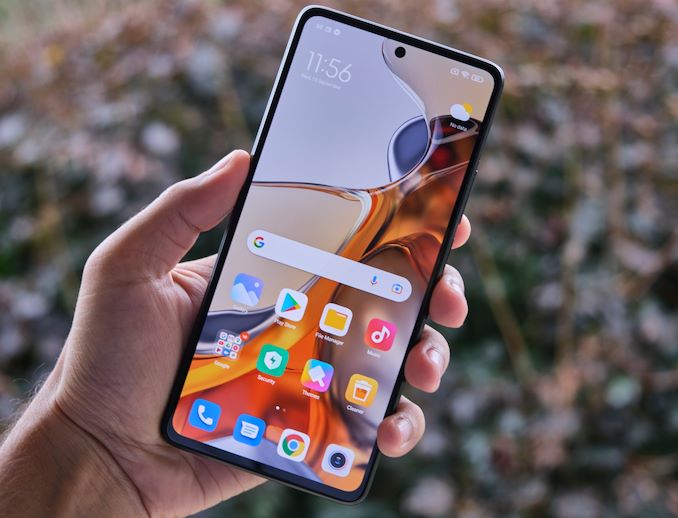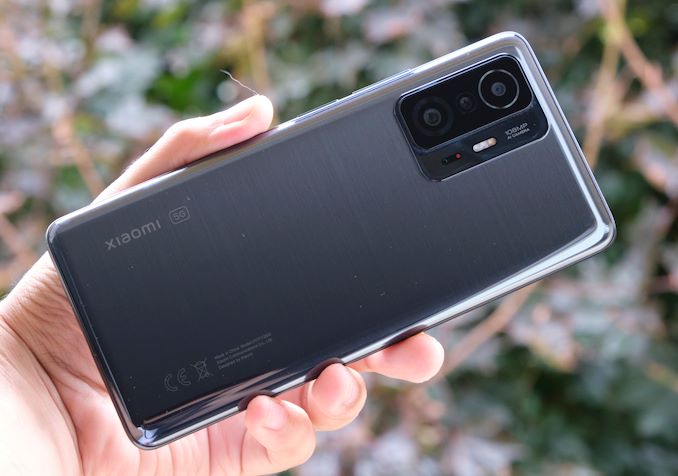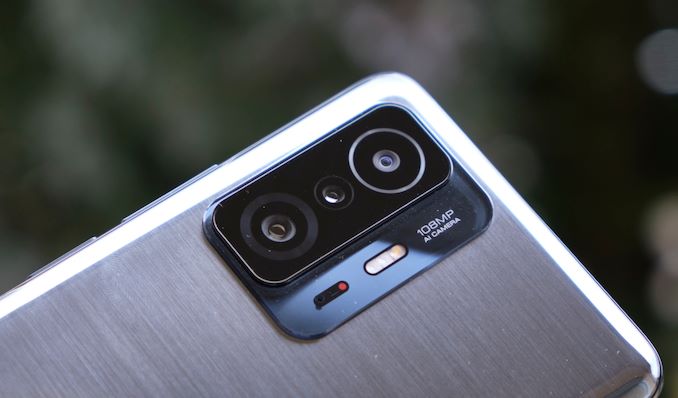The Xiaomi 11T & 11T Pro Review: Two Chips, With a Battery Focus
by Andrei Frumusanu on September 15, 2021 9:00 AM EST- Posted in
- Mobile
- Smartphones
- Xiaomi
- Xiaomi 11T
- Xiaomi 11T Pro

Today Xiaomi is announcing three new devices – the 11T, the 11T Pro and the 11 Lite 5G NE. We’ve had the first two in for review for a bit now and are able to give some first-hand experiences with the phones today.
The Xiaomi 11T series – which by the way isn’t called anymore “Mi” in the name, it’s literally just “Xiaomi 11T” now, are supposed to be additions to the company’s flagship line-up, but coming in at lower price points. We had reviewed the Mi 11 back in March and the big brother, the Mi 11 Ultra in July, so make sure to read those pieces as the 11T series fits into the line-up, albeit being different.
What defines the 11T series is the fact that they’re slightly lower priced and more budget than the original Mi 11, notably on the display side which has now been reduced to a 1080p panel. Build quality is also different, and finally, we’re seeing a different set of SoC options depending on whether you get the regular 11T or the higher-end 11T Pro.
| Xiaomi 11T Series | |||
| 11T | 11T Pro | ||
| SoC | MediaTek Dimensity 1200 1x Cortex-A78 @ 3.00GHz 3x Cortex-A78 @ 2.60GHz 4x Cortex-A55 @ 2.00GHz Mali-G77MP9 |
Qualcomm Snapdragon 888 1x Cortex-X1 @ 2.84GHz 3x Cortex-A78 @ 2.42GHz 4x Cortex-A55 @ 1.80GHz Adreno 660 @ 840MHz |
|
| DRAM | 8GB LPDDR5-6400 | 8/12GB LPDDR5-6400 | |
| Display | 6.67" AMOLED 2400 x 1080 120Hz Refresh 480Hz Touch HDR10+ / 10-bit panel |
||
| Size | Height | 164.1mm | |
| Width | 76.9mm | ||
| Depth | 8.8mm | ||
| Weight | 203g | 204g | |
| Battery Capacity | 5000mAh (Typical) 67W Charging |
5000mAh (Typical) 120W Charging |
|
| Wireless Charging | - | - | |
| Rear Cameras | |||
| Main | 108MP HM2 1/1.3" 0.7µm 9:1 Binning to 12MP / 1.4µm f/1.75 24mm eq. |
||
| Telephoto | 5MP (Macro only) f/2.4 48mm eq. |
||
| Extra Telephoto |
- | ||
| Ultra-Wide | 8MP f/2.2 120° FoV |
||
| Extra | - | ||
| Front Camera | 16MP f/2.45 |
||
| Storage | 128/256GB | ||
| I/O | USB-C | ||
| Wireless (local) | 802.11 (Wifi 6), Bluetooth 5.2 |
||
| Cellular | 4G + 5G NR NSA+SA Sub-6GHz | ||
| Special Features | Capacitive side fingerprint sensor (power button) Full-range stereo speakers IR Blaster |
||
| Splash, Water, Dust Resistance | No rating | ||
| Dual-SIM | 2x nano-SIM | ||
| Launch OS | Android 11 w/ MIUI | Android 11 w/ MIUI | |
| Launch Price | 8+128GB: 499€ 8+256GB: 549€ |
8+128GB: 649€ 8+256GB: 699€ 12+256GB: 749€ |
|
Starting off with the SoCs, the two 11T devices are absolutely interesting phones as besides the usual Samsung Galaxy devices each year who are powered by Snapdragon and Exynos SoCs, Xiaomi is employing a similar strategy here with the 11T series in dual-sourcing both from Qualcomm and from MediaTek.
The regular 11T is powered by the MediaTek Dimensity 1200 “Ultra” – we’re not sure what the Ultra here stands for but it seems it’s related to a high clocked NPU – there are no differences on the CPU clocks. The SoC features a Cortex-A78 at up to 3.00GHz, three A78’s at 2.60GHz, and four A55’s at 2.00GHz. The GPU is a MaliG77MP9, although we can’t confirm the frequency. This is MediaTek’s highest end chip at this moment in time, so it’s quite interesting. What also makes it special is that it’s on TSMC’s 6nm process node, and it’s the first chip we’ve had in our hands on this node.
The Snapdragon 888 needs no introduction, and that’s what’s powering the 11T Pro. There are a few oddities with the chip though, which we’ll cover in the system performance section, but the way Xiaomi is configuring the chip isn’t quite flagship level in terms of behaviour.
What’s very exciting about the two devices with differing SoCs is that both phones are otherwise absolutely identical in specifications. It’s essentially the same phone, just with a different SoC, and different charging capabilities. For apples-to-apples chipset comparisons, it rarely gets better than this, though we’ll see that there are behavioural discrepancies.
The back of the phone is relatively generic with its glass back. One thing to note here is that the phone is a bit more on the wider side at 76.9mm. Weight is reasonable at 203-204g due to the 5000mAh battery.
In general, the build quality and design of the phone isn’t quite as attractive and sleek as what we saw on the Mi 11, and it does feel like a slightly cheaper / lower end model in the Mi 11 flagship series.
On the camera side of things, Xiaomi is employing a 108MP sensor, but this is not the HMX that was found in the Mi 11 but rather the smaller HM2 sensor which uses 0.7µm pixels compared to 0.8µm on the sibling. The optics are 24mm equivalent focal length at f/1.75 aperture, but without OIS.
There’s a 5MP telephoto module but this is only used for macro shots, it can’t be used for any actual zooming in.
Finally, there’s a basic 8MP ultra-wide with f/2.2 and 120° field of view – it’s really basic. In general, the whole camera setup is simple and Xiaomi doesn’t give it too great specifications.
Xiaomi is focusing around fast-charging in these devices, notably the 11T Pro comes with a 120W charger. It performs as advertised; however, we’ll be talking about the topic in more depth in the review.
The 11T starts at 499€, which is quite reasonable, and the 11T Pro starts at 649€ - which is actually quite steep given that one can have the Mi 11 for around 715€ nowadays, the phone would have to somehow rationalise itself in its differentiations compared to its series sibling.














41 Comments
View All Comments
zodiacfml - Wednesday, September 15, 2021 - link
not only does 120w charging is crazy, it also appears to charge at a high rate even at 80% battery state. tricks I know is to use two batteries in series and using larger capacity batteries than advertised or lower voltage cutoff. however, those tricks don't appear enough to get up to 120w.yetanotherhuman - Thursday, September 16, 2021 - link
It'd be nice to see some phones again one day, and not just phablets.Linustechtips12 - Thursday, September 16, 2021 - link
very much agreed I will not ever go for an iPhone sorry... but I want the size in between something like the 13 mini and the regular 13 or just a smidge smaller than the s21, the s21 is actually almost perfect coming from an s10e I hope the overall size of the 22 is slightly smaller or the same size as the s10eTheinsanegamerN - Friday, September 17, 2021 - link
So, on a phone like this, how would that work with US carriers? It's not officially sold here, will it work with VoLTE or will these phones be bricks once the 3G networks go down?ATT and verizon are very picky about what is allowed, and while most US sold phones are supported they say nothign about xaiomi.
coolkwc - Sunday, September 19, 2021 - link
If you ever own a fast charging phone and power meter, you will know the 'algorithm' behind the fast charging. The charge current is reduce in staggered, however from what i saw, it is based on temperature capped rather than preset according to SoC. You will noticed that it will reduce the charge in order to keep temperature under 40'C. So if your phone temperature is at the high side when you plug in the charger, the fastest charge rate will not even activated/sustained for any longer, however it will sustain longer if the charge temperature is low. I'm using the Mi 11 Ultra with 67W charger, to preserve the battery life i normally charge using my old QC3.0 samsung charger at home and only charge until 4.3V which is 85-90% full, the sustain charge current is at around 3.5A for the whole charging period. The bundle 67W Xiaomi charger serve as my quick 'travel' charger where i will use when i need a fast top up, which not often based on my use case.Plumplum - Monday, September 20, 2021 - link
Installation of monitoring apps can show problems with CPU behavior...why wasn't it done on the first test?ROM was responsible of the problem.
Problem with Anandtech is how fast they're to accuse Mediatek without asking them questions on how the device and sometime some benchmarks (such as PCMark) behave.
That was already the same with so called cheating.
Unfortunatelly post people won't read the corrected article. The damage is done!
Should made a separate article to apologize!
Premade thought leads to unfair review.
iphonebestgamephone - Saturday, September 25, 2021 - link
Nothing was wrong in cheating one back then. Mediatek not including the cheat mode in dimensity should be enough to tell you all about it.xol - Monday, September 20, 2021 - link
Hot take 1The Cortex X1 is a bad core. Not bulldozer bad but pentium hot/bad/inneficient, which is doubly bad in a mobile environment. ARM added lots of cache and didn't add enough functional units to make it worthwhile. It's half the M1 design - all the cache but lacks the pipeline. bad.
Hot Take 2
Manufacturers (qualcom/xiaomi) know this but can't avoid using latest/"best" core in their latest designs because product spec sheets > actual real world utility.
Hot Take 3
Manufacturers know this too (hot take 2) but still need to use the "bad" X1 cores in their flagships because they need to be "flagship". But the core is crappy and give bad battery life. So they're compensating by essentially disabling as much as they can. (pretty much fact and not hot take)
A ide Hot Take 4
Snapdragon 888 is a "bad" chip too, and not just the X1 core, also the GPU. Quallcomm use the node advantage (5 vs 7nm) to squeeze extra frequency out of their designs, They claim +50% ALU in the new chip (vs 865) but/and clock it at 840 vs 650MHz (+29%). But performance is only +25%. There's real world evidence that the 888 runs hot and thermally throttles in phones way earlier than 865, despite being on 5nm -
sweetca - Tuesday, September 21, 2021 - link
I prefer my spying domestic.Yourdailytask - Thursday, September 23, 2021 - link
hello admingrate post